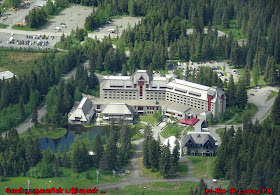Wildlife Viewing at Potter Marsh Anchorage
Potter Marsh, at the southern end of the Anchorage Coastal
Wildlife Refuge, is an ideal break from Anchorage for birders and other
wildlife viewers. From the Seward Highway just before the left turn into the
Potter Marsh parking lot, you are treated to a stunning view of Turnagain Arm.
A wooden boardwalk winds 1,550 feet from the parking area through the marsh and
across watery openings and sedges, perfect habitat for a rich variety of birds.
From late April
through September, Canada geese, northern pin-tails, canvasback ducks,
red-necked phalaropes, horned and red-necked grebes, and northern harriers use
this wetland. Look for eagle nests in the cottonwoods near the base of the
bluff using binoculars or a spotting scope. Eagles have a sharp sense of sight and
can see at least four times better than people, enabling them to detect
movements of small animals like hares from a mile away. When eagles soar
overhead, they are scanning open areas for prey.
Notable Species in Potter Marsh Birds Sanctuary
·
Chinook salmon
·
Coho salmon
·
Beaver
·
Moose
·
Muskrat
·
Trumpeter swan
·
Northern pintail
·
Green-winged teal
·
Canvasback
·
Red-necked grebe
·
Northern harrier
·
Sandhill crane
·
Arctic tern
·
Red-winged blackbird
From May to August,
gulls, Arctic terns, shorebirds such as yellow-legs, and occasionally trumpeter
swans are present during spring and fall migration.
In addition to
birds, look for slow movement and a v-shaped wake in the waters of the marsh,
signs of muskrats swimming past. Their small brownish heads peek just above the
water as they meander in and out of the wetland's open areas.
Moose also frequent
the marsh year-round. May and June are good times to see these large ungulates
standing in the marsh foraging for new growth.
About halfway along
the boardwalk, Rabbit Creek flows underneath and provides a good spot to see
spawning chinook, coho, or humpback salmon from May to August, depending on the
species. Spot their bright red bodies swimming in the creek.
With its nearly panoramic
view of Turnagain arm, Potter Marsh, buffered by spruce, cottonwoods and
alders, is one of the most accessible and scenic wildlife viewing areas in
Anchorage.
Located at the
southern end of the Anchorage Coastal Wildlife Refuge, the 540-acre Potter
Marsh offers easy access to nature, with a 460-meter-long wheelchair-accessible
wooden boardwalk.
Driving Direction to
Potter Marsh Bird Sanctuary : Seward Highway milepost 117.4. Take the signed
Potter Marsh exit to the east (toward the mountains), then follow the road
south to a parking lot by the boardwalk. For other views, there are two highway
pullouts off Seward Highway along Potters Marsh between mileposts 116 and 117
and a parking area off Potter Valley Road at the south end of the marsh at
milepost 115.6. Parking is limited to these pullouts.





















































